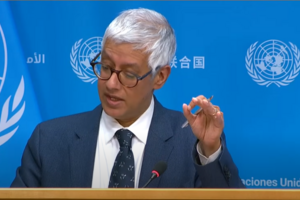From Discourse to Discord: Dissecting Antisemitism on Campus

This piece was originally published by Divided We Fall (Mixed). It was written by David Finkel, Detroit Steering Committee Member, Jewish Voice for Peace, and Mark S. Cogan, Associate Professor of Peace and Conflict Studies, Kansai Gaidai University.
By David Finkel – Detroit Steering Committee Member, Jewish Voice for Peace
The issue of antisemitism on university campuses is a difficult one in the horrifying wake of Israel’s assault on Gaza following the October 7th Hamas attack. In the U.S. Congress, much of the media, and in what passes for mainstream “Jewish community leadership,” any Palestinian expressions opposing Israel’s war and occupation are labeled as “antisemitic.” As a result, chapters of Students for Justice in Palestine and dissident Jewish forces like Jewish Voice for Peace have been banned on multiple campuses.
Palestinian, Arab, and Muslim students are living in a climate of fear for their physical safety and future job prospects as they are publicly “doxxed” by pro-Israel extremist organizations, such as the Canary Mission or the more respectable Anti-Defamation League. Palestinian and Arab faculty are also under assault, including a popular tenured Indiana University professor Abdulkader Sinno, who was suspended and threatened with firing.
Understanding real antisemitism requires a proper definition: Antisemitism is defined as hostility toward or discrimination against Jews as a religious, ethnic, or racial group. Like all forms of racism, it is odious. Before October 7th, most antisemitic violence in the United States wasn’t about Israel. The infamous far-right Charlottesville march (“Jews will not replace us”) was clear neo-Nazism. Jewish congregants of the Tree of Life synagogue in Pittsburgh were targeted for a murderous attack because of its pro-immigrant activism.
Because of Israel’s claim to be “the nation-state of the Jewish people,” and Prime Minister Netanyahu’s vow that only Jewish sovereignty will exist “between the Jordan River and the Mediterranean Sea,” the war and massacre in Gaza creates a dangerous confusion. If someone says, “The Jews are carrying out genocide in Gaza,” that is antisemitic. I have not heard any such statement at any Palestine solidarity march or Arab community meeting that I have attended.
If someone says, “The state of Israel is carrying out genocide in Gaza,” that claim can be evaluated and confirmed by referring to the United Nations Convention on Genocide. That may be painful and even offensive to supporters of Israel, Jewish or non-Jewish, but it is not antisemitic and it needs to be part of any meaningful dialogue.
How dialogue is conducted is very important. I agree that nobody on either side of the debate should be physically assaulted, threatened, or intimidated. University administrations have a responsibility to ensure peace. I would remind everyone that at present, there are many more documented serious threats to Palestinian and Arab students and faculty; however, Jewish people and all other community members have equal rights to safety and protection.
By Mark S. Cogan – Associate Professor of Peace and Conflict Studies, Kansai Gaidai University
Antisemitism is real at America’s universities. It existed long before the terrible events of October 7th, when Hamas terrorists attacked over 1,100 innocent people, including Israelis and foreign nationals. However, we should not frame antisemitism exclusively in the context of the present conflict.
While the protests on college campuses, like that of Columbia University, are eye-opening and concerns about police brutality are valid, we should also remember the history of antisemitism at Columbia itself. In the 1920s, Jewish student populations reached 40 percent before being capped because of negative public sentiment toward the Jewish people. As Berkeley sociologist Dr. Jerome Karabel once wrote in his 2006 book on antisemitism at elite American schools, an old college song demonstrates the normalized hate of Jewish students:
As Oh, Harvard’s run by millionaires
And Yale is run by booze,
Cornell is run by farmers’ sons,
Columbia’s run by Jews.
While Mr. Finkel is right to document instances where pro-Palestinian groups and Jewish peace groups have been banned from classes or where there have been hostile attacks on Palestinian or Arab students and faculty, there is a danger in his writing that suggests disproportionality. While he correctly defines antisemitism as “hostility toward or discrimination against Jews as a religious, ethnic, or racial group,” he leaves out a trail of documented evidence of the growing wave of antisemitism that has swept across colleges and universities for many years, even suggesting there are “many more documented serious threats to Palestinian and Arab students and faculty in the present.”
Incidents of antisemitism were rising prior to 2023 with the Anti-Defamation League reporting that instances of antisemitism increased 36 percent overall in 2022 and increased 41 percent on college campuses. This issue is not just limited to the U.S., as antisemitic incidents are up 211 percent since October 7th in Toronto, Canada with spikes across France and the U.K. as well. According to Hillel International, a Jewish campus organization, more than 840 incidents of antisemitism occurred on college campuses since the start of the Israel-Hamas war in October.
Missing from the debate is the frightening effect the campus protests have had on Jewish student populations. Jewish students at Columbia no longer feel safe on campus, and some have reported either being the target of protesters’ ire or hearing extreme anti-Jewish rhetoric from pro-Palestinian protesters at Columbia University. At Cooper Union, a small New York City college, Jewish students wearing yarmulkes felt targeted as pro-Palestinian protestors banged on the doors and windows of the library where they were studying.
These incidents are just a fraction of antisemitic incidents that fully fall within his definition. Antisemitism on America’s college campuses is real. And we cannot ignore it.
By David Finkel – Detroit Steering Committee Member, Jewish Voice for Peace
Since the beginning of this exchange, the issues involved have become more explosive and sharply clearer in some ways, while perhaps murkier in others.
First and foremost, the full genocidal scale of Israel’s assault on Gaza has become undeniable–including the targeting of journalists and medical workers, the destruction of Gaza’s universities, the deliberate killing of whole families of presumed (actual or alleged) Hamas operatives, the starvation of the population as a weapon of war, and alleged mass execution sites at hospitals the Israel Defense Forces raided. The Israeli government’s unmistakable intention is the irreversible destruction of Palestinian society in Gaza and, increasingly, in the West Bank too.
This inescapable reality is why student encampments and demands for divestment from Israel-complicit corporations have mushroomed across the United States and why Jewish students are among the most active participants in them. These campaigns are not motivated or driven by antisemitism, but by the reality of live-streamed genocide. The core organizers of these campaigns include Arab and Palestinian students, some of whom have lost extended family members in Gaza or know others who have, and Jewish activists horrified by the crimes against humanity committed in their name with U.S. tax dollars.
While antisemitism is not the movement’s driving force, there are antisemitic incidents occurring in the United States (more off campuses than on) that are grounds for legitimate alarm. This is where things become murky. Unfortunately, statistics and reports from Hillel International and the Anti-Defamation League are entirely unreliable since these organizations have signed up as agents of Israeli hasbara and intelligence services.
Examples of purported “campus antisemitism” include an incident with an individual, unconnected to the movement, spewing Jew-hating rants outside the Columbia campus. In a particularly egregious case, Northeastern University administration called police to break up the campus movement upon reports of “Kill the Jews” chants–which video footage appears to show coming from a provocateur carrying an Israeli flag.
One actual example of a protest leader at Columbia suggesting “Kill Zionists” was immediately repudiated by the movement. Columbia and Barnard professor of anthropology Nadia Abu El-Haj has made an important observation that everyone has the right to be safe on campus and elsewhere, but not to shut down protest activities simply if they feel unsafe without actual cause. Real documented attacks on “pro-Israel students” seem to be quite rare.
Worst of all, the U.S. Congress has passed a resolution declaring “targeting of Israel” to be “antisemitic.” Besides advancing the far-right agenda of taking over liberal arts university education in order to destroy it, this vicious and false conflation makes it even harder to identify and root out real antisemitism.
By Mark S. Cogan – Associate Professor of Peace and Conflict Studies, Kansai Gaidai University
For the sake of clarity, note that the issue we are discussing is not Israel’s military incursion into Gaza. While I acknowledge Israel’s right to self-defense, my first instinct would be diplomacy and the use of force in a proportional and measured fashion. With that said, much of Mr. Finkel’s rebuttal does not address the central issue of this discussion: the existence and prevalence of virulent antisemitism in America’s colleges and universities. While Mr. Finkel notes that the student encampments are motivated by the perception of genocide, the debate over this term and its implications fuels anger and misdirected hatred toward the Jewish students who study at these institutions.
If Mr. Finkel acknowledges that “there are antisemitic incidents occurring in the United States (more off campuses than on) that are grounds for legitimate alarm,” he should not then minimize certain accounts. Antisemitism at Columbia is rife, as an account in The Guardian illustrates. Jewish students were called “Nazi b——” and told to “go back to Poland.” One female student at Columbia was confronted by a pro-Palestinian demonstrator who demanded to know if she was a Zionist. That incident caused her to stop wearing her Star of David necklace. The May 5th account of Columbia Ph.D. student Iddo Gefen in The Atlantic cites the increasingly extreme rhetoric used by protestors.
The dangerous choice of language and hateful rhetoric, whether it fits Mr. Finkel’s definition of antisemitism or not, has caused Jewish students to feel both unsafe and increasingly isolated on college campuses for actions they have no active part in or any control over. How could they possibly feel comfortable when protesters casually use profane language such as, “F— Israel, Israel’s a b——.” These accounts are important as they justify, in the eyes of Jewish students, the need for universities to take action to ensure their safety on campus.
I would also ask Mr. Finkel and many pro-Palestinian protesters to understand the complexities of Jewish identity. One can be a Jewish student but not be cast with the label of “pro-Israel.” One can also support Israel while having concerns about its military tactics or settlement policy. Hateful rhetoric forces students to comply with black-and-white definitions of what it means to be Jewish. Similarly, in the progression of conflict, polarization among groups intensifies and pushes out-groups into convenient, lump-sum enemies.
The key to resolving the current crisis of hate on college campuses is to have respectful dialogue to avoid intractable positions. Legitimate conflict resolution means that all parties must be willing to engage in productive dialogue aimed at articulating each group’s needs and understanding the root causes of the conflict. While it remains doubtful that a resolution to the demands made by pro-Palestinian groups will be found, it would be more productive to engage in discussions on campuses promoting understanding rather than pointing fingers of rage at Jewish students who have no role in the cause of the student anger.


May 16th, 2024

May 16th, 2024

May 16th, 2024